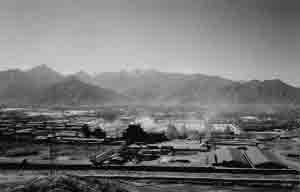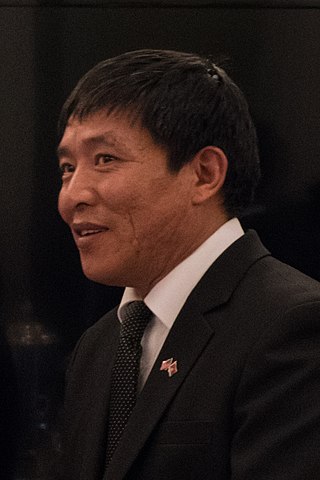Related Research Articles

Lobsang Trinley Lhündrub Chökyi Gyaltsen was the tenth Panchen Lama, officially the 10th Panchen Erdeni, of the Gelug school of Tibetan Buddhism. According to Tibetan Buddhism, Panchen Lamas are living emanations of the buddha Amitabha. He was often referred to simply as Choekyi Gyaltsen.
Free Tibet (FT) is a non-profit, non-governmental organisation, founded in 1987 and based in London, England. According to their mission statement, Free Tibet advocates for "a free Tibet in which Tibetans are able to determine their own future and the human rights of all are respected."

The history of Tibet from 1950 to the present includes the Chinese invasion of Tibet in 1950, and the Battle of Chamdo. Before then, Tibet had been a de facto independent nation. In 1951, Tibetan representatives in Beijing signed the Seventeen-point Agreement under duress, which affirmed China's sovereignty over Tibet while it simultaneously provided for an autonomous administration led by Tibet's spiritual leader, and then-political leader, the 14th Dalai Lama. During the 1959 Tibetan uprising, when Tibetans arose to prevent his possible assassination, the Dalai Lama escaped from Tibet to northern India where he established the Central Tibetan Administration, which rescinded the Seventeen-point Agreement. The majority of Tibet's land mass, including all of U-Tsang and areas of Kham and Amdo, was officially established in 1965 as Tibet Autonomous Region, within China.

Dolma Kyab, born in 1976, is a writer and teacher in his native Tibet. He was imprisoned at Chushur Prison, which is located in a rural area south-west of his native home, Lhasa, Tibet. On March 9, 2005, he was arrested in Lhasa at the middle school where he was employed as a history teacher. On September 16, 2005 he was convicted and sentenced to 10 years in prison by the Lhasa People’s Intermediate Court for the crime of stealing and/or passing on “state secrets.”

Runggye Adak is a Tibetan man who was arrested and charged with state subversion against the People's Republic of China after making a series of public political statements at a festival in eastern Tibet, on August 1, 2007.

The 1959 Tibetan uprising began on 10 March 1959, when a revolt erupted in Lhasa, the capital of Tibet, which had been under the effective control of the People's Republic of China (PRC) since the Seventeen Point Agreement was reached in 1951. The initial uprising occurred amid general Chinese-Tibetan tensions and a context of confusion, because Tibetan protesters feared that the Chinese government might arrest the 14th Dalai Lama. The protests were also fueled by anti-Chinese sentiment and separatism. At first, the uprising mostly consisted of peaceful protests, but clashes quickly erupted and the Chinese People's Liberation Army (PLA) eventually used force to quell the protests, some of the protesters had captured arms. The last stages of the uprising included heavy fighting, with high civilian and military losses. The 14th Dalai Lama escaped from Lhasa, while the city was fully retaken by Chinese security forces on 23 March 1959. Thousands of Tibetans were killed during the 1959 uprising, but the exact number of deaths is disputed.

Drapchi Prison, or Lhasa Prison No. 1, is the largest prison in Tibet, China, located in Lhasa. Drapchi is named after its location and was originally a military garrison until it was converted into a prison after the 1959 Tibetan Uprising. It is roughly one mile from the city centre and is the main prison for judicially sentenced prisoners in Tibet. It was the primary place for the detention of political prisoners before 2005 when the newer and modernised Chushur Prison was built. Drapchi also goes by the name Delapuxie prison, which has sometimes been listed as a separate prison online.

Ngawang Sangdrol is a former political prisoner, imprisoned at the age of 13 by the Government of the People's Republic of China, for peacefully demonstrating against the Chinese occupation of Tibet in 1992. She was at first held for eight months without trial, before being sentenced to a three-year prison term. Her sentence was extended repeatedly for continued protest in prison, which included recording a tape of freedom songs with 13 other nuns from Drapchi Prison that was smuggled out of Tibet.
Phuntsog Nyidron is a Tibetan Buddhist nun and a former high-profile prisoner in Tibet. In 1989, she and eight other nuns traveled from her hometown to the provincial capital of Lhasa when it was convulsed by Tibetan independence protests and riots, and handed out leaflets and shouted anti-Chinese slogans. She was tried and imprisoned for the charge of counterrevolutionary propaganda and incitement and imprisoned at the Drapchi Prison that same year. During her incarceration, she produced and smuggled out tapes of her and other prisoners' political songs, engaged in hunger strikes, and made publicized allegations of mistreatment. One of the better-known Tibetan prisoners outside Tibet, she was the subject of a release campaign by several United States Congress parliamentarians and governmental groups. Because of their efforts, and Chinese wishes to improve Sino-American relations, her sentence was reduced and commuted in 2004. She lives in Switzerland since 2006.

The 2008 Tibetan unrest, also referred to as the 2008 Tibetan uprising in Tibetan media, was a series of protests and demonstrations over the Chinese government's treatment and persecution of Tibetans. Protests in Lhasa, the capital of Tibet, by monks and nuns on 10 March have been viewed as the start of the demonstrations. Numerous peaceful protests and demonstrations were held to commemorate the 49th anniversary of the 1959 Tibetan Uprising Day, when the 14th Dalai Lama escaped from Tibet. The protests and demonstrations spread spontaneously to a number of monasteries and throughout the Tibetan plateau, including into counties located outside the designated Tibet Autonomous Region. The arrest of monks at Labrang Monastery increased the tension of the situation. Violence began when Chinese police and People's Liberation Army units used force on non-violent protests by monks and nuns, and spread when protesting Tibetans later clashed with security forces. Clashes also occurred between Tibetans and Chinese Han and Hui residents, resulting in Han and Hui stores and buildings being destroyed and numerous Chinese civilians being injured or killed.

Phüntsok Wangyal Goranangpa, also known as Phüntsog Wangyal, Bapa Phüntsok Wangyal or Phünwang, was a Tibetan politician. A major figure in modern Sino-Tibetan relations, he is best known for being the founder and leader of the Tibetan Communist Party. He was arrested by the Chinese authorities in 1960 and subsequently spent 18 years in the infamous Chinese high security prison Qincheng in solitary confinement. After his release he lived in Beijing until his death.
The 1987–1989 Tibetan unrest was a series of protests and demonstrations that called for Tibetan independence. These protests took place between September 1987 and March 1989 in the Tibet Autonomous Region, in the Tibetan regions of Sichuan, and Qinghai, as well as the Tibetan prefectures in Yunnan and Gansu. Protests began shortly after the Dalai Lama, the religious and temporal leader of Tibet exiled in India since the 1959 Tibetan unrest, proposed a Five Point Peace Plan regarding the “status of Tibet” on September 21, 1987, which was subsequently rejected by the Chinese government. The Plan advocated for greater respect and autonomy of the Tibetan people, and claimed that “Tibet was a fully independent state when the People’s Liberation Army invaded the country in 1949-50.” China rejected the idea of Tibetans as an invaded people, stating that “Tibet is an inalienable part of Chinese territory” and has been for hundreds of years. The Tibetan sovereignty debate is longstanding, and the Tibetan assertion that they are a separate and unique people invaded by China has become a central argument for their independence.
Passang Lhamo is a Tibetan nun, former political prisoner, activist.
Human rights in Tibet is a contentious issue. Even though the United States advocates the human rights of the Tibetan people and even though it once provided funds to the Dalai Lama's independence movement, the United States does not participate in the Tibetan sovereignty debate and as a result, it does not recognize Tibet's right to exist as a country. Reported abuses of human rights in Tibet include restricted freedom of religion, belief, and association; arbitrary arrest; maltreatment in custody, including torture; and forced abortion and sterilization. The status of religion, mainly as it relates to figures who are both religious and political, such as the exile of the 14th Dalai Lama, is a regular object of criticism. Additionally, freedom of the press in China is absent, with Tibet's media tightly controlled by the Chinese leadership, making it difficult to accurately determine the scope of human rights abuses.

Protests and uprisings in Tibet against the government of the People's Republic of China have occurred since 1950, and include the 1959 uprising, the 2008 uprising, and the subsequent self-immolation protests.

Jigme Gyatso (aka Golog Jigme) is a Tibetan filmmaker and human rights activist. After assisting with the documentary Leaving Fear Behind, he was arrested by Chinese authorities on at least three occasions. He alleges that he was tortured following his March 2008 arrest.

Dhondup Wangchen is a Tibetan filmmaker imprisoned by the Chinese government in 2008 on charges related to his documentary Leaving Fear Behind. Made with senior Tibetan monk Jigme Gyatso, the documentary consists of interviews with ordinary Tibetan people discussing the 14th Dalai Lama, the Chinese government, the 2008 Beijing Olympics, and Han Chinese migrants to the region. After smuggling the tapes of the interviews out of Tibet, however, Dhondup Wangchen and Jigme Gyatso were detained during the 2008 Tibetan unrest.

Jigme Gyatso is a Tibetan activist of the Tibetan Independence Organisation who, in 1996, was sentenced to 15 years in prison on charges of "leading a counter-revolutionary organisation" and "inciting splittism". Two more years were added to his sentence in 2004 when he protested in jail. Several international human rights groups have protested or campaigned on his behalf, and Amnesty International has designated him a prisoner of conscience.
Prostitution in Tibet is thought to have existed for centuries. Testimonies of its existence were provided by outside visitors in the first half of the twentieth century. According to the British writer Christopher Hale, due to the practice of polyandry in Tibet, many women were unable to find a husband and moved to villages and towns, where they fell into prostitution. Their clients came from the caravans crossing the Tibetan plateau, and also from the monasteries.

Lukar Jam Atsok or commonly Lukar Jam, born 1972, in Tsolho Dragkartri district, in Amdo, Tibet. He is a Tibetan refugee and political activist that ran for Prime Minister of the Tibetan Government-in-Exile in Dharamshala, India in 2016. A former Chinese political prisoner, Lukar Jam went on to become President of the non-profit Gu-Chu-Sum, dedicated to the welfare of Tibetan political prisoners. He has worked as a civil servant with the Tibetan Government-in-Exile and currently lives in the Tibetan enclave of McLeod Ganj, high above Dharamsala, India in the western foothills of the Himalayas.
References
- 1 2 Gulotta, Nick (5 March 2009). "Profiles in Courage: Day 7 – March 4th". Students for a Free Tibet. Retrieved 27 August 2015.
- 1 2 3 4 "Action: Political Prisoner Profiles". Tibet Society. August 2011. Retrieved 28 August 2015.
- 1 2 "Australian aid group says Tibet worker has been missing since March". New York Times. 22 November 2008. Retrieved 27 August 2015.
- ↑ "Tibet: Seven Sentenced to Life Imprisonment". Unrepresented nations and Peoples Organisation. Punjab Newsline. 22 December 2008. Retrieved 27 August 2015.
- ↑ "NGO worker sentenced to life imprisonment: harsh sentences signal harder line on blocking news from Tibet". savetibet.org. International Campaign for Tibet. 22 December 2008. Retrieved 27 August 2015.
- ↑ "Severe beatings and arrests continue in Tibet". Phayul. Dharamshala. 14 March 2012. Archived from the original on 26 April 2015. Retrieved 27 August 2015.